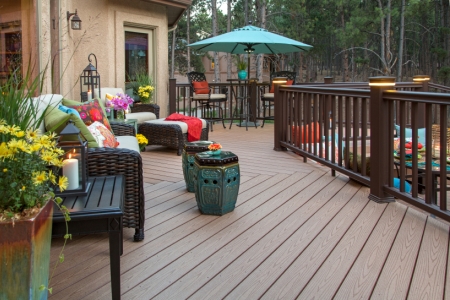

5 Misconceptions About Composite Decking
 (Family Features)—Composite decking has been an option for homeowners for over 20 years—yet misconceptions about it still exist. Decking and railing brand Trex Company and HGTV’s “Decked Out” stars Paul Lafrance and Kate Campbell debunk the most common composite myths below. (Family Features)—Composite decking has been an option for homeowners for over 20 years—yet misconceptions about it still exist. Decking and railing brand Trex Company and HGTV’s “Decked Out” stars Paul Lafrance and Kate Campbell debunk the most common composite myths below.Myth #1: Composite decking looks unnatural. “Composite decking has evolved tremendously since its beginnings more than 20 years ago,” says Campbell. Products today mimic natural wood well, Campbell says, with a range of grains and finishes that replicate woods naturally found all over the world. Myth #2: Every composite deck is manufactured from the same material. “Since composite decking was invented in the early 1990s, the market has been flooded with competitive offerings varying widely in quality, aesthetics and value,” Lafrance says. “For my projects, I use what is categorized as 'high-performance' composite manufactured with an integrated, three-sided shell, or 'cap.' Capped boards feature an added layer of protection against severe weather, heavy foot traffic, fading, mold and staining.” Myth #3: Composite decks do not need maintenance. “Anything that sits outside in the elements for years on end is going to need some type of maintenance,” Campbell says. “When it comes to decking, the difference lies in how much upkeep is required.” Natural wood decking requires regular sanding, sealing and/or staining, and can splinter, warp or rot, raising the potential for more costly maintenance measures; composite decking only requires a rinse twice each year, says Campbell. Myth #4: Composite decking is costly. “Over time, wood decking actually ends up being more expensive than composite,” Lafrance says. “Sure, the initial cost of pressure-treated lumber is less than wood alternatives, but since a deck is a long-term investment, it's important to consider the long-term costs, such as all the materials you'll need for seasonal stripping, staining, painting and sealing. “Add to that the time and cost involved in repairing and replacing wooden deck boards that will inevitably warp and splinter over time—even if they are well-maintained. When you factor in the cost of ongoing maintenance required with a wood deck, a composite deck ends up paying for itself in the long run.” Myth #5: Composite decking is not eco-friendly. The opposite is true. “Because it is made primarily from recycled content, composite decking is remarkably eco-friendly,” Campbell says. There are several sustainable options available to homeowners, says Campbell. Consult with a composite decking manufacturer to learn how its products are produced with the planet in mind. Source: Trex Company |
Today's Top Stories |
